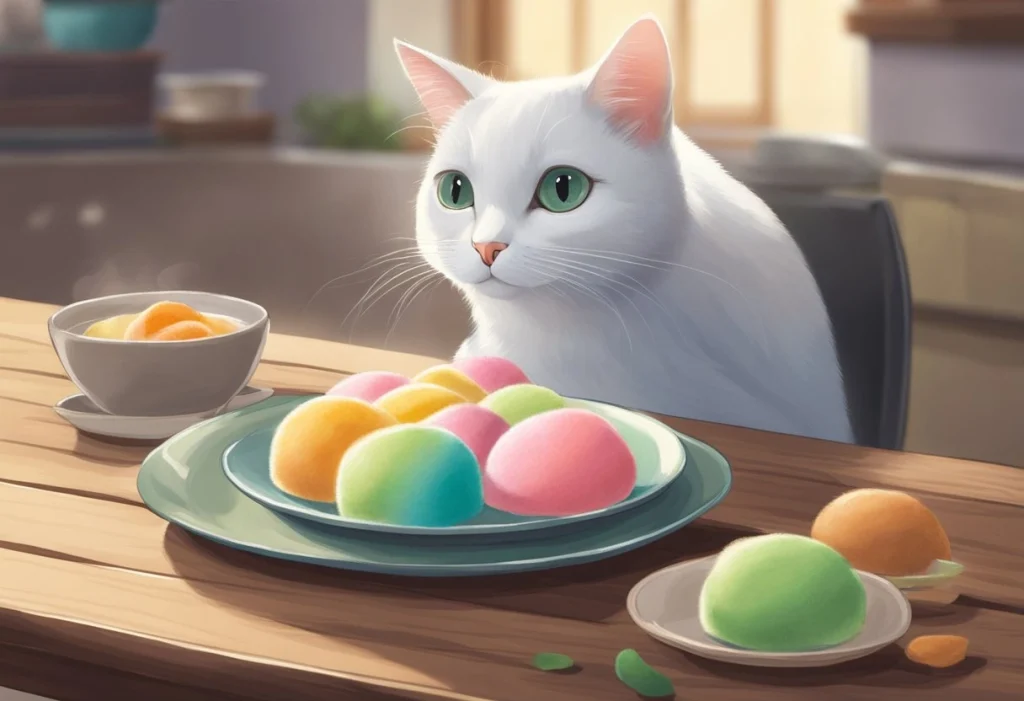Can Cats Eat Mochi? Understanding the Risks and Dietary Needs for Your Feline Friend
By: Lana Koh

The information in this article is intended to educate cat parents and is not a substitute for veterinary guidance. In case of any concerns about your cat’s health, please talk with your veterinarian.
Curious cat owners often wonder about sharing their favorite treats with their pets. One such treat is mochi, a sweet rice cake popular in Japanese cuisine. While mochi is not toxic to cats, it is best to avoid giving it to them due to its high carbohydrate content.
Cats have specific dietary needs that differ from humans. They are obligate carnivores, meaning their diet should primarily consist of meat. Although some human foods can be harmless or even beneficial for cats, mochi, especially if it contains fillings or sweeteners, is not suited for their digestion.
If you’re considering mochi as a treat for your feline friend, it’s essential to be cautious and informed. This blog post will explore whether cats can eat mochi and what pet owners should know about their cat’s health and diet.
Key Takeaways:
- Mochi is a Japanese sweet, but it should not be shared with cats.
- Cats require a meat-based diet for optimal health.
- Understanding cat dietary needs can help prevent potential health issues.
Also Read: Can Cats Eat Moths?
Understanding Mochi and Its Origins
Mochi is a popular Japanese rice cake made from glutinous rice and comes in various forms and flavors. Its origins are deeply rooted in Japanese culture, where it serves both as a delicious treat and a traditional food during celebrations.
Ingredients and Types of Mochi
Mochi is primarily made from glutinous rice, which is pounded into a sticky paste. This unique texture allows it to be shaped into various forms. Common types of mochi include:
- Daifuku: Mochi filled with sweet red bean paste or other fillings like fruit or ice cream.
- Wagashi: Traditional Japanese confections where mochi is often used as a base, showcasing artistry and seasonal themes.
- Nerikiri: A type of wagashi made from mochi and other ingredients like sweetened bean paste, shaped into beautiful designs.
Mochi can be enjoyed plain or flavored, and it’s often used in both sweet and savory dishes. It is also versatile, being used in desserts, soups, and snacks.
Also Read: Can Cats Eat Mushrooms?
History of Mochi in Japanese Culture
Mochi has a long historical significance in Japan, dating back over a thousand years. It was originally used in religious ceremonies and was considered a symbol of prosperity and good fortune.
In Japanese culture, mochi is especially significant during the New Year celebrations, where it features in dishes like ozoni, a traditional soup.
Also Read: Can Cats Eat Tuna?
Cats and Their Dietary Needs
Understanding the dietary needs of cats is essential for their health. Cats are obligate carnivores, which means their diet consists of meat. Human foods, especially plant-based options, can introduce risks. Pica, the eating of non-food items, is another concern for cat owners.
Basics of Feline Nutrition
Cats require a balanced diet rich in proteins, fats, and certain vitamins. Their bodies thrive on animal-based proteins, like those found in salmon and chicken. Unlike dogs, cats cannot synthesize certain nutrients, such as taurine and arachidonic acid, making animal sources essential.
Carbohydrates should be minimal. Cats don’t have the digestive enzymes to process large amounts of carbs effectively. Quality commercial cat foods are designed to meet these nutritional needs.
A proper diet also includes hydration. Cats are less inclined to drink water, so wet food can help maintain their moisture intake. Owners should always ensure their cat has access to fresh water.
Risks of Human Foods to Cats
Many human foods are unsafe for cats. Foods like chocolate and onions are toxic and can lead to serious health issues. Even safer options, like fruits, should be given with caution due to high sugar content.
Plant-based products, while common in vegan diets, do not provide the essential nutrients cats need. Ingredients like grains and vegetables can cause digestive issues. If a cat consumes too much of these, it may lead to health problems.
Moderation is key. If owners wish to share treats, it’s advisable to stick to small amounts and ensure they are suitable for feline consumption.
Read: Can Cats Eat Tofu?
Understanding Pica in Cats
Pica is a condition where cats eat non-food items. This behavior can stem from stress, boredom, or nutritional deficiencies. It can lead to serious health risks, including intestinal blockages.
Some cats might crave items like paper, plastic, or fabric. Owners should closely monitor their pets and provide enriching environments to reduce stress and prevent pica.
If a cat shows signs of pica, it is crucial to consult a veterinarian. They can help determine if the behavior is linked to a dietary issue or another health concern.
Can Cats Safely Eat Mochi
Mochi is a popular treat made from glutinous rice, but it may not be safe for cats to consume. Understanding the potential risks and safer alternatives can help cat owners make informed decisions.
Potential Dangers of Mochi for Cats
Mochi’s texture and ingredients can pose risks to cats. While mochi is not toxic, its high carbohydrate content can lead to digestive issues. Cats are obligate carnivores and do not require carbohydrates.
Additionally, flavored mochi, like those containing fruit or sweets, may have harmful ingredients. For example, mochi filled with chocolate is dangerous, as chocolate can be toxic to cats. Symptoms of chocolate toxicity include vomiting, diarrhea, and in severe cases, seizures.
Another risk includes the physical properties of mochi. Its sticky texture can pose choking hazards and may lead to gastrointestinal blockages. If a cat appears to have difficulty swallowing or shows signs of distress, it is crucial to seek veterinary attention.
Read: Is Pumpkin a good food for Cats?
Symptoms to Watch for After Ingestion
If a cat accidentally eats mochi, owners should monitor for specific symptoms. Common signs of digestive upset include:
- Vomiting: This may happen if the cat’s stomach cannot handle the foreign substance.
- Diarrhea: A cat may have loose stools as its body reacts to the treat.
- Lethargy: A decrease in activity can indicate that something is wrong.
It is essential to pay attention to any unusual behavior after consumption. In some cases, more serious symptoms may develop, such as abdominal pain or signs of choking. If any severe symptoms occur, it is best to contact a veterinarian for advice.
Safer Treat Alternatives for Cats
Instead of mochi, cat owners can choose healthier alternatives. Some suitable options include:
- Cooked Salmon: Rich in omega-3 fatty acids, salmon is a nutritious treat when prepared without added oils or spices.
- Commercial Cat Treats: Many brands offer treats specifically formulated for cats, ensuring they meet dietary needs.
- Small amounts of cooked chicken or turkey: These protein sources are often favorites among cats and provide necessary nutrients.
These options not only satisfy a cat’s cravings but also support their health. Always introduce new treats gradually and in moderation to avoid upsetting their stomach. If unsure about a specific food, consulting a veterinarian is advisable.
Interesting Read: Why does my cat’s breath smells like fish?
Frequently Asked Questions
Mochi can raise several concerns for cat owners. Understanding its components and potential effects on cats is important for their health. This section answers common questions regarding mochi and related sweet treats.
Conclusion
While mochi isn’t toxic to cats, its high-carb content and potential additives make it an unsuitable treat for your feline friend. Cats thrive on a meat-based diet, and human sweets like mochi can cause digestive issues or even pose choking hazards. Instead, opt for vet-approved treats that align with their nutritional needs.
Understanding your cat’s dietary restrictions ensures their long-term health and happiness. If you’re tempted to share a snack, always research first—or stick to safer alternatives like cooked salmon or commercial cat treats. When in doubt, consult your veterinarian to keep your pet safe and satisfied.

About the Author
Lana Koh
Lana is a passionate cat lover with years of experience caring for her feline companions. As a dedicated volunteer at animal shelters, she’s gained valuable insights into the world of cats. Lana channels her love and knowledge into writing informative and engaging articles for fellow pet owners, covering topics like cat health, nutrition, grooming, behavior, and the special bond we share with our feline friends.
